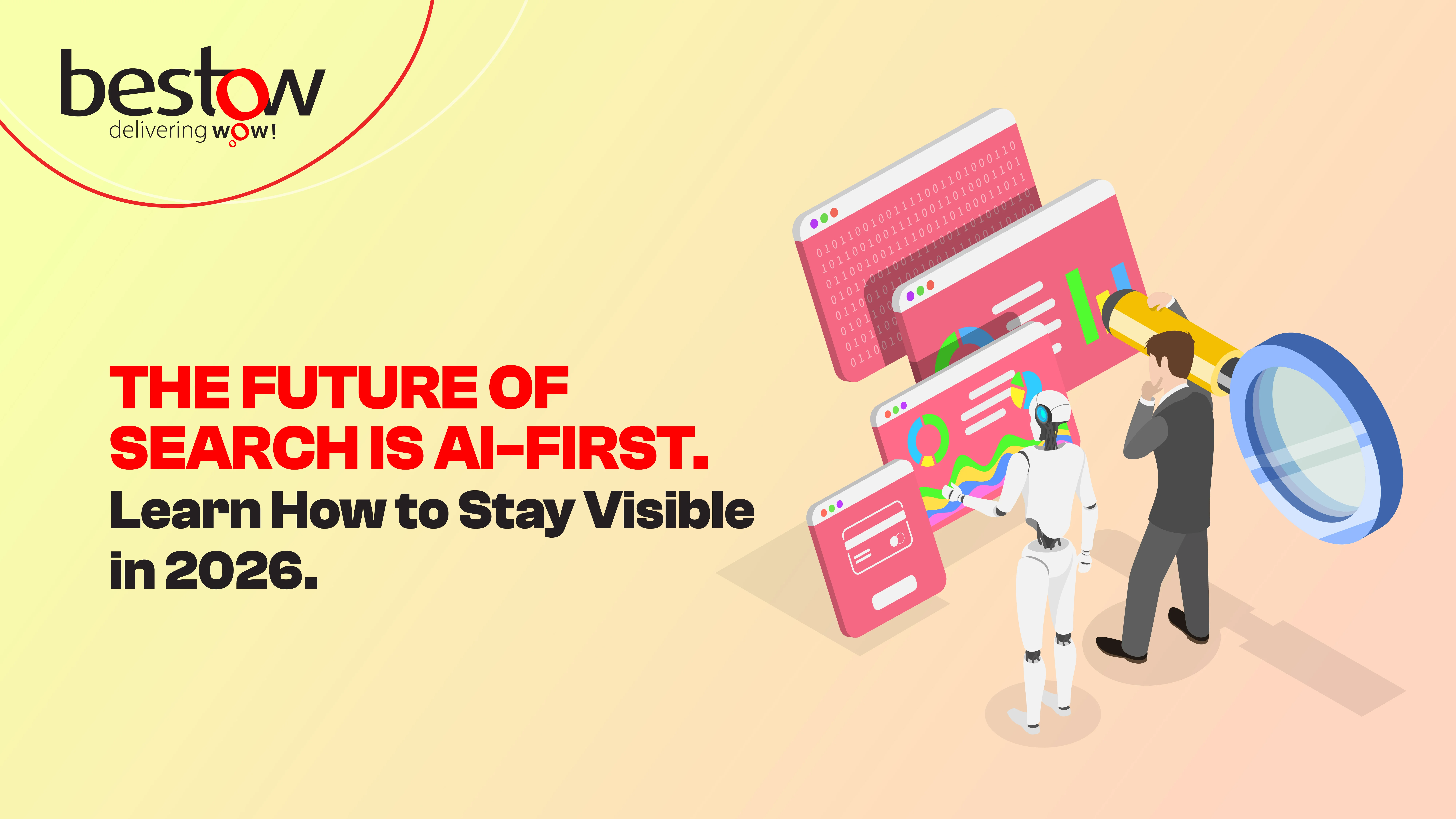How Generative Engine Optimization (GEO) Will Change SEO in India in 2026

25/11/2025
Start Listening
How Generative Engine Optimization (GEO) Will Change SEO in India in 2026
Search is changing faster than ever — and in India, that shift is even more dramatic. As millions of Indians move from Google searches to AI conversations with platforms like ChatGPT, Gemini, Bing Copilot, and Perplexity, the rules of visibility are being rewritten.
This is where Generative Engine Optimization (GEO) services comes in. For Indian brands preparing for the next wave of digital disruption, GEO isn’t just another marketing trend — it’s the new foundation of SEO in the AI era.

What Is Generative Engine Optimization (GEO)?
Before we explore the impact of GEO, it’s important to understand the concept.
Generative Engine Optimization involves optimizing content so that AI engines can accurately interpret, cite, and feature your brand within generated responses. Unlike traditional SEO, which focuses on ranking webpages, GEO focuses on the visibility of your content inside AI-generated output — the new front page of the internet.
Why GEO Is Becoming Critical in India
As India moves to AI-first search, user behaviour is shifting rapidly.
Indian users are adopting conversational, voice-led, multilingual search patterns. This shift has created a new environment where brands must optimize for how generative engines understand and present information — not just how Google ranks pages.
1. The Shift in Indian Search Behaviour
Voice-first users
India has one of the world’s highest populations of voice-search users, driven by mobile-first internet access and the popularity of assistants like Google Assistant and Alexa. GEO supports natural-language queries that voice searches typically generate.
Regional language queries
Generative AI understands Indian languages better than ever. From Hindi to Gujarati and Tamil, millions are using regional languages for queries — and AI engines respond more precisely than traditional search.
Shorter, conversational searches
Queries are becoming natural and specific, like: “Which CA firm is reliable for small businesses in India?” GEO ensures your content appears as direct answers to these conversational prompts.
2. India’s Explosion of AI Adoption (Stats + Trends)
India is one of the fastest-growing markets for AI usage. More users — from students to small business owners — now rely on generative engines instead of browsing multiple websites. To understand how AI is reshaping digital strategies in India, Bestow has compared both approaches in its detailed guide on AI vs Traditional SEO Services — a must-read for brands preparing for this transition.

Why GEO Will Overtake Traditional SEO for Many Queries
AI engines increasingly provide zero-click answers, meaning users do not leave the AI interface to visit websites. When the answer is generated instantly, SEO rankings matter far less. This is why GEO vs SEO is becoming one of the most important comparisons for digital marketers. GEO ensures your content gets cited, referenced, and surfaced uniquely in AI outputs — even when users never click through to Google.
How GEO Will Transform SEO Strategies in 2026
SEO is not dying — but it is evolving. GEO represents the next major shift in how Indian brands stay discoverable. To understand this transformation deeply, Bestow’s guide on GEO emerging as the new SEO explains the strategic shift brands must prepare for.
1. From Keywords to “Answer Optimization”
Traditional SEO focuses on keywords. GEO focuses on clear, structured answers that AI engines can extract and reuse.
2. From Ranking Pages to Ranking Passages
AI engines do not rely on whole webpages — they rely on passages. Short explanations, definitions, and numbered lists become key for AI-driven search optimization India.
3. From Backlinks to “Citations in AI Outputs”
Backlinks remain useful, but the new authority metric is whether your content is mentioned in AI-generated summaries. This is the foundation of AI overview citation optimization.
4. Optimizing for AI Summaries, Not Just SERPs
GEO requires writing for AI reasoning:
Clear claims
Sourced facts
Short, structured insights
This signals reliability to generative engines like ChatGPT and Gemini.

5. Entity Building and Brand Structuring for GEO
GEO depends on strong digital entities. LLMs need to know who you are, what you do, and what you are an authority on.
This includes:
Schema markup
Author entities
Brand consistency
Topic clusters
This is vital for LLM optimization for Indian websites.
What GEO-Friendly Content Will Look Like in 2026
The format of content will matter as much as the keywords used. GEO demands content formats designed for machine understanding — not long, fluffy blogs written only for SEO.
1. Structured, Fact-Rich, Source-Backed Content
AI engines favour credible, verifiable insights. The more structured your content is, the more likely it will appear in summaries.
2. Content Built Around Questions, Not Keywords
GEO encourages content that answers actual questions users ask, making it ideal for how to do GEO for brands strategies.
3. First-Party Insights, Case Studies & Proprietary Data
Indian brands sharing original insights will gain more visibility in AI responses.
4. Crisp, Semi-Structured Content AI Can Parse Easily
Short sentences, bullet points, numbered lists, and H3s help AI extract meaning quickly.
5. Multi-Format Content (Text + Short Video + Micro-FAQs)
Generative engines increasingly use video transcripts and FAQ snippets — so multi-format content boosts GEO performance.
Impact of GEO on Indian Businesses
Every business category—local shops, D2C brands, tech companies—will see measurable impact. For a deeper India-specific perspective, refer to Bestow’s research on the future of digital marketing in Gujarat, which highlights how AI is reshaping regional markets.
1. Local Businesses & GEO (Voice + Regional Search)
Voice search and language diversity favour businesses optimized for conversational prompts.
2. D2C Brands (Product Comparisons in AI Summaries)
AI-generated comparison charts will determine visibility. Brands with structured product data will dominate.
3. EdTech, Finance, Real Estate (High-Expertise Sectors)
These sectors require trust signals, making Generative AI content optimization essential.
4. How GEO Will Lower Visibility for “Thin” Content Businesses
AI engines ignore generic, fluffy content. Brands relying on low-quality blogs will lose all visibility in AI outputs.
How Bestow Helps Brands Prepare for GEO
Indian companies need a future-ready strategy combining GEO, SEO, and AI-driven visibility. Bestow supports businesses with GEO-focused content architecture, AI powered SEO services, entity-building and schema markup, and structured content designed for LLM understanding
You can explore Bestow’s full suite of Generative Engine Optimization services and how they help brands dominate in the AI era.
To build your customized GEO plan with our team, book a call with us today!
FAQs
GEO is the practice of optimizing content so generative AI engines can interpret it, cite it, and include it in their output.
Traditional SEO focuses on ranking webpages, while GEO focuses on appearing within AI-generated answers and summaries.
India’s search behaviour is rapidly shifting toward AI engines. Brands without GEO will lose visibility across conversational and voice-led queries.
They scan structured content, extract key passages, evaluate authority, and cite reliable information inside their generated outputs.
Use structured content, question-based formatting, schema markup, factual data, and micro-answers.
Provide clear, short, definition-style passages AI can reuse directly.
Yes. Schema markup helps AI engines understand entities, authors, FAQs, reviews, and content relationships.
Track citations in AI outputs, branded mentions in AI summaries, and visibility across engines like Perplexity.
Thin content may disappear entirely, and brands must maintain accuracy to avoid misinformation in AI outputs.
No — SEO remains important for transactional intent. GEO dominates informational and conversational intent.
Search will be conversational, voice-led, regional, and AI-curated — with fewer clicks and more instant answers.
Yes. GEO uses natural-language structuring, making it ideal for voice-first users.
Publish deep insights, build author entities, and maintain consistent topical authority.
Yes. GEO naturally optimizes for ChatGPT, Gemini, Bing Copilot, and emerging Indian LLMs.
Use hybrid content:
GEO for educational, conversational queries
SEO for transactional keywords and conversion paths
Categories
Recent Blogs
Send us a message
We'd love to hear from you
Let's build a plateform that works for you busines and the advertisers who trust it.
Talk to Our Expert